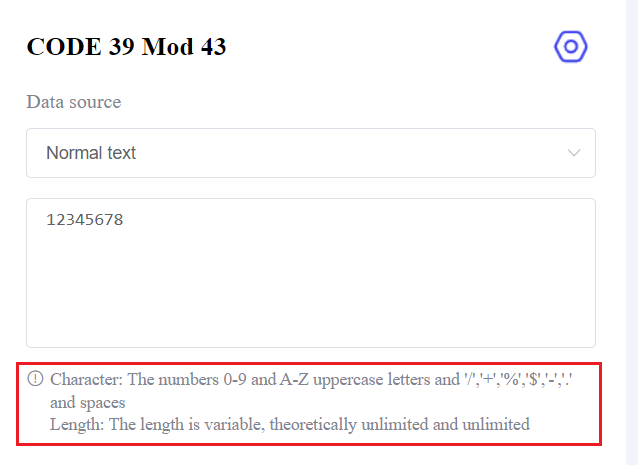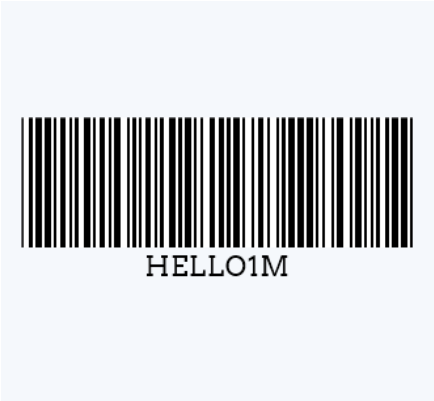Barcodes play a role in tracking and managing products across various industries. Among the different barcode standards, Code 39 Mod 43 stands out due to its enhanced accuracy and reliability.
This article will explore Code 39 Mod 43, explaining what it is, how it works, and why it is essential for ensuring accurate data capture.

Code 39 is a widely used barcode symbology that encodes alphanumeric characters.
Each character in Code 39 is represented by a combination of nine elements (five bars and four spaces), hence the name "Code 39." While Code 39 is versatile, it does not include an inherent error-checking mechanism, which can sometimes lead to inaccuracies in data capture.
What is Code 39 Mod 43?
Code 39 Mod 43 is an enhanced version of the Code 39 barcode. The key difference is the inclusion of a Modulo 43 checksum digit at the end of the barcode. This checksum helps ensure the accuracy of the encoded data, reducing the likelihood of errors when using barcode scanners.
How Does Code 39 Mod 43 Work?
The Code 39 Mod 43 system adds a layer of security to the standard Code 39 barcode by including a checksum. Here's a step-by-step breakdown of how it works:
1. Data Encoding: First, the alphanumeric data is encoded using the Code 39 symbology. This involves converting each character into a specific pattern of bars and spaces.
2. Checksum Calculation: Each character in the barcode has a corresponding value (A=10, B=11, ..., Z=35, 0=0, 1=1, ..., 9=9). These values are summed together, and the sum is divided by 43. The remainder of this division is the Mod 43 checksum value.
3. Appending the Checksum: The checksum character, corresponding to the Mod 43 value, is appended to the end of the barcode. This final step ensures that any errors in data capture are detectable.
4. Verification During Scanning: When the barcode is scanned, the system recalculates the checksum from the scanned data and compares it to the appended checksum. If they match, the data is accurate; if not, an error is indicated.
Why Use Code 39 Mod 43?
The primary advantage of using Code 39 Mod 43 is its ability to catch errors. Here are some reasons why it might be chosen over standard Code 39:
1. Error Detection: The Mod 43 checksum helps prevent data inaccuracies, especially important in industries where precision is crucial, such as healthcare or automotive manufacturing.
2. Versatility: Like Code 39, Code 39 Mod 43 can encode a wide range of characters, making it suitable for diverse applications.
3. Ease of Implementation: Despite the added checksum, Code 39 Mod 43 is easy to generate and scan, requiring minimal changes to existing Code 39 systems.
How to Calculate Mod 43 Check Digit?
The Mod 43 check digit is used in Code 39 Mod 43 barcodes to verify data accuracy. Here's how you calculate it:
1. Assign Values to Characters:
Each character in Code 39 is assigned a value:
● Numbers (0-9) = 0 to 9
● Letters (A-Z) = 10 to 35
● Special characters like dash (-), dot (.), space, dollar ($), slash (/), plus (+), and percent (%) = 36 to 42.
2. Sum the Values:
Add the values of all the characters in your data string.
3. Divide by 43:
Divide the sum by 43 and find the remainder.
4. Determine the Check Digit:
The remainder corresponds to the check digit, a character from the Code 39 set.
Example of Code 39 Mod 43
Let's calculate the Mod 43 check digit for the string "HELLO1":
1. Assign Values:
● H = 17
● E = 14
● L = 21
● L = 21
● O = 24
● 1 = 1
2. Sum the Values:
17 + 14 + 21 + 21 + 24 + 1 = 98
3. Divide by 43:
98/3 = 2 remainder 12
4.Determine the Check Digit:
The remainder is 12, which corresponds to the character M in Code 39.
So, the Mod 43 check digit for "HELLO1" is M. The complete Code 39 Mod 43 string becomes "HELLO1M".

Applications of Code 39 Mod 43
Code 39 Mod 43 is widely used in scenarios where data accuracy is crucial, particularly in industries that require reliable data verification. Below are more specific applications along with simple examples:
1. Automotive Industry:
Tracking parts and components during assembly to ensure that the correct parts are used in manufacturing.
A car manufacturer encodes part numbers using Code 39 Mod 43 on labels. When parts arrive at the assembly line, scanners verify the Mod 43 checksum to ensure the correct parts are used, minimizing the risk of assembly errors.
2. Healthcare:
Labeling patient medications to ensure correct prescriptions and dosages are administered.
A hospital pharmacy uses Code 39 Mod 43 barcodes on medication bottles. When nurses scan the barcode before administering medication, the system checks the Mod 43 checksum to confirm the medication matches the patient's prescription, reducing the risk of medication errors.
How to Generate Code 39 Mod 43 Barcodes?
Generating a Code 39 Mod 43 barcode with an online barcode generator, you can easily create these barcodes without needing specialized software. Here's how:
1. Input Data: Enter the alphanumeric data you want to encode.

2. Generate Barcode: The tool generates the barcode with the correct format.
3. Download and Print: After generating your barcode, you can download it in your preferred format and print it using a barcode printer.
This process makes it easy for businesses to create reliable barcodes that ensure data accuracy.
In summary, code 39 Mod 43 offers a significant improvement over the standard Code 39 barcode by adding a Modulo 43 checksum for error detection.
This makes it an excellent choice for industries where data accuracy is non-negotiable.
Whether you're in healthcare, automotive, or any other sector that requires reliable barcoding, Code 39 Mod 43 ensures that your data is captured accurately.
To generate these barcodes quickly and efficiently, use an online barcode generator. It's a simple and effective way to ensure your barcodes are accurate and meet industry standards.





